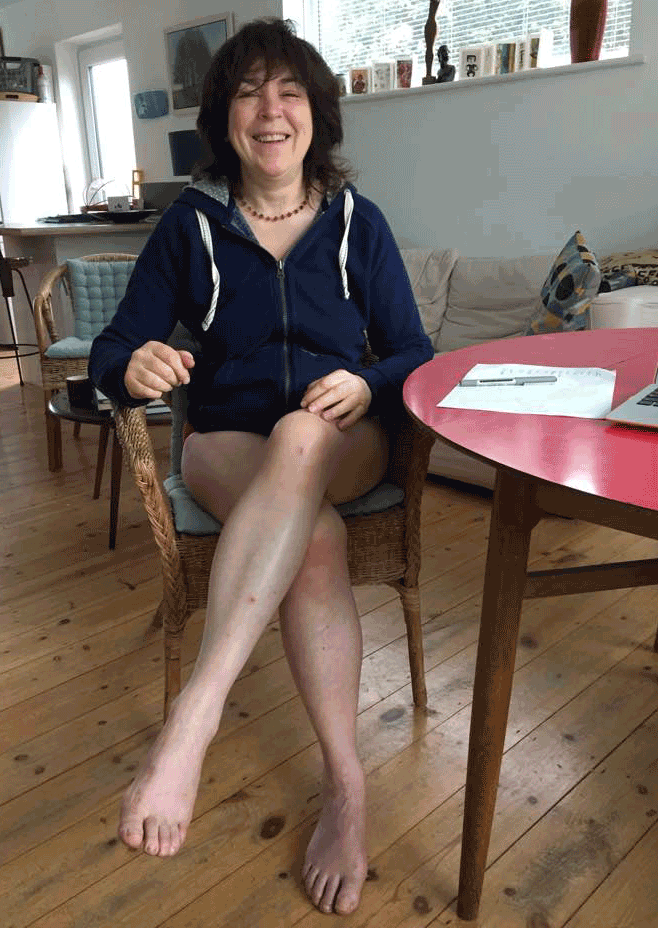Oh good god. Air B&B in Yeovil with mein host Alan, who (it turns out) runs a Christian ministry from his home. He rises early, reads a few verses from the Bible, then records his thoughts on video which he uploads to YouTube. So far, so you-can-put-all-the-scatter-cushions-you-like-on-the-bed-but-it-can’t-hide-the-fact-your-mattress-is-abysmal.
He had assured us he wasn’t “one of those”; he wouldn’t be “all preachy”. Alan is married to an Ethiopian woman called Taffy and there is an obese and aging labrador the colour of chocolate called Tess. There is a large rectangular pond with a fountain that slightly overplays onto the path. Broken paving slabs have been placed to resemble a rockery all around, with plastic fern fronds intermittently positioned. At night the fountain is lit from below, and in the continually changing colours of the illumination you can view the cascade slowly, inevitably emptying the water into the garden. Especially when the wind picks up.
The helpful information sheet on the bedside table invites me to treat myself to one of Taffy’s legendary facials (£18); and tells me there will be a selection of ‘serials’ available at breakfast. I wasn’t very hungry so I just had an episode of Poldark and nibbled a Grey’s Anatomy with a sneaky GoT on the terrace.
Alan joined us for breakfast. There was an enormous widescreen TV over the table showing a paused Breitbart video. As Tess leant her copious frame against my legs and fell asleep, we fell into conversation of sorts, which was mainly Alan talking. Alan apparently ran the B&B to meet people. He kept saying “to be honest with you”. He told us he had guests from all over the world. Yesterday, a lovely Australian couple; people from Russia; and last week a very nice Chinese couple who happened to be Christians. “To be honest with you”, he went on, “I always thought the Chinese gave Christians a hard time, but apparently not.”
I might just have muttered something at this point about the Chinese government handpicking priests, about continuous harassment and corruption, and the state-sponsored publication of a “corrected” version of the Bible. I don’t recall exactly, but it never takes much to coax the worm from its hole.
Alan agreed that there’s a lot of corruption in the world, but that changes are coming. Alan had been visited by God and now Alan had a prophecy that he would like to share with us. Fortunately, through my own genealogical research on the Mormon website, I had been able to establish on Heather’s mother’s tree—via the Amish connection—a direct line back to Charlemagne and from there to Jesus of Nazareth. Uncle JNaz wasn’t immediately available for comment, so I’m unable to verify Alan’s impressive claim, but I’m not the doubting sort. And anyway, as he was keen to remind us, he was being honest with us.
A new movement was afoot that would wipe away all the corruption. God had trumpeted his personal choice of ambassador, a man of strength and righteousness who would lead this change. This is what God had chosen to share with Alan, and now Alan was passing this on to us. This was indeed exciting news. I wiggled my feet, overheating under the snoring Tess. She stirred just enough to shift her weight again, securing my legs under Alan’s table while he finished outlining his vision for the New World Order.
I felt the worm needed nothing more than a little nudge of encouragement to get it over the line. I casually enquired whether he’d be prepared to let us know the name of the person now chosen to do God’s work on Earth.
To be honest with you, it’s someone whose name you know well. An American gentlemen of high office. Alan explained that the wall was necessary to keep “them” all out, of course, but he wasn’t a racist because he was married to an Ethiopian, obviously, but if we just left our borders open they would soon overrun us and take everything we have. Alan didn’t go into a lot of detail but he seemed especially triggered by Hillary Clinton: “Some of the things she’s done, I can’t bring myself to say but it makes me want to vomit”, he revealed, as I dug out the last of the raspberry jam from the individual portion with my knife. “Tony Blair, Gordon Brown and especially Obama, they’ll all be behind bars”.
It’s quite a lot to take in, and perhaps a bit harsh on Gordon Brown, but Alan was fairly confident on these main facts. Sadly, Heather was already, and increasingly, feeling the pull of the open road, and was now standing, downing the last of her tea in a single anxious gulp before pulling Tess by her collar, freeing me at last.
We shook hands and said our goodbyes.
Alan asked us to write a review.
I’l be honest with you.













